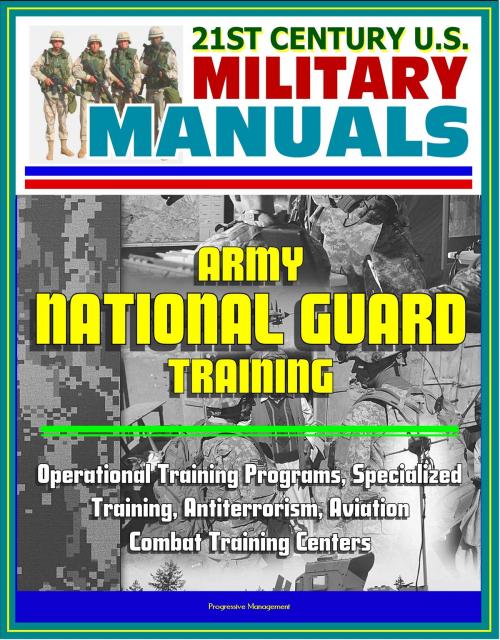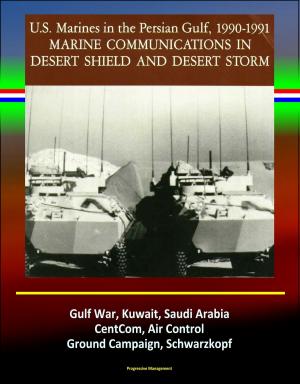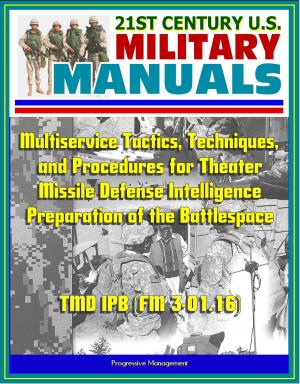21st Century U.S. Military Manuals: Army National Guard Training - Operational Training Programs, Specialized Training, Antiterrorism, Aviation, Combat Training Centers
Nonfiction, History, Military, United States| Author: | Progressive Management | ISBN: | 9781301393176 |
| Publisher: | Progressive Management | Publication: | March 20, 2013 |
| Imprint: | Smashwords Edition | Language: | English |
| Author: | Progressive Management |
| ISBN: | 9781301393176 |
| Publisher: | Progressive Management |
| Publication: | March 20, 2013 |
| Imprint: | Smashwords Edition |
| Language: | English |
The primary objective of the ARNG is to train units that can mobilize, deploy, fight and win anywhere in the world. Our units must be prepared to deploy and fight worldwide with a minimum of post-mobilization training time. The key to this objective is unit readiness through aggressive training programs. Unit leaders are directly responsible for developing and executing sound and challenging training programs that support the wartime mission of their units. The secondary objective of the ARNG is to provide organized units or personnel for defense support of civil authorities (DSCA). Training for these contingencies should be integrated with the training for wartime missions. Such training allows ARNG units to be more effective by reducing the needed response time and using all available resources within the community to the maximum extent.
Chapter 1 * General * 1-1. Purpose * 1-2. References * 1-3. Explanation of abbreviations and terms * 1-4. Mission * 1-5. Objective * 1-6. Training Strategy * Chapter 2 * Responsibilities * 2-1. General * 2-2. Chief, National Guard Bureau * 2.3. Commander, US Army Forces Command (FORSCOM) * 2.4. Commander, U.S. Army Special Forces Command (USASOC) * 2-5. Director, Army National Guard (DARNG) * 2-6. Commander, First US Army (FUSA) * 2-7. The Adjutants General (TAG) * 2-8. Unit Commanders (UC) * Chapter 3 * Training and Duty Administration * 3-1. General * 3-2. Unit Training Programs * 3-3. Minimum Personnel and Training Standards * 3-4. Individual Readiness for Training or Duty * 3-5. Attachment of Individuals * 3-6. Training in Non-Pay Duty Status * 3-7. Training and Duty Authorization * 3-8. Inactive Duty Types * 3-9. Inactive Duty Training Periods and Assemblies * 3-10. Unit Training Assemblies (UTA) and Rescheduled Training Assemblies (RTA) * 3-11. Correspondence Courses * 3-12. Distributed Learning Courses * 3-13. Non-Prior Service (NPS) Personnel Training Program * 3-14. Annual Training (AT) Planning * 3-15. Annual Training Authority * 3-16. Attendance-Units * 3-17. Attendance-Individual * 3-18. Year-Round Annual Training * 3-19. Additional Man-Day Support for Annual Training * 3- 20. Schools * Chapter 4 * Operational Training Programs * 4-1. General * 4-2. Selective Service Training * 4-3. Defense Support of Civil Authorities (DSCA) * 4-4. Small Unit Exchange Program * 4-5. Equipment Maintenance (CONUS) * 4- 6. Overseas Deployment for Training (ODT) * 4.7. ARNG SOF Deployment for Training * Chapter 5 * Specialized Training * 5-1. General * 5-2. Antiterrorism and Force Protection * 5-3. Medical Training * 5-4. Maintenance Training * 5-5. Intelligence Training * 5-6. Special Operations Forces (SOF) Training * 5-7. Aviation Training * 5-8. Mobilization Training and Exercises * 5-9. Marksmanship Training * 5-10.Smalls Arms Firing Schools (SAFS) * 5-11.NG Sniper Course Total Army Training System * 5-12.Small Arms Readiness/Mobilization Instructor Course (SARMIC) * 5-13.State Marksmanship Coordinators Training Course (SMCTC) * 5-14.Advanced Marksmanship Unit Readiness Course (AMURC) * 5-15.Small Arms Simulation Course (SASC) * 5-16.Training Conferences * 5-17.Electronic Warfare Training * Chapter 6 * Modernization Training * 6-1. Summary * 6-2. Execution * Chapter 7 * Combat Training Centers * 7-1. Purpose * 7-2. Execution * 7-3. Resourcing * 7-4. Battle Command Training (BCT) Program * 7-5. Joint Readiness Training Center (JRTC) * 7-6. National Training Center (NTC) * 7-7. Combat Division Refresher Course (CDRC) and Combat Brigade Refresher Course (CBR * 7-8. Coordination * Chapter 8 * Training Support * 8-1. General * 8-2. Training Site Management * 8-3. Annual Training Site Selection * 8-4. National Guard Bureau Recognized Training Sites * 8-5. Garrison Training Center (GTC) Category Levels and Profiles * 8-6. Training Ammunition * 8-7. Training Aids, Devices, Simulators, and Simulations
The primary objective of the ARNG is to train units that can mobilize, deploy, fight and win anywhere in the world. Our units must be prepared to deploy and fight worldwide with a minimum of post-mobilization training time. The key to this objective is unit readiness through aggressive training programs. Unit leaders are directly responsible for developing and executing sound and challenging training programs that support the wartime mission of their units. The secondary objective of the ARNG is to provide organized units or personnel for defense support of civil authorities (DSCA). Training for these contingencies should be integrated with the training for wartime missions. Such training allows ARNG units to be more effective by reducing the needed response time and using all available resources within the community to the maximum extent.
Chapter 1 * General * 1-1. Purpose * 1-2. References * 1-3. Explanation of abbreviations and terms * 1-4. Mission * 1-5. Objective * 1-6. Training Strategy * Chapter 2 * Responsibilities * 2-1. General * 2-2. Chief, National Guard Bureau * 2.3. Commander, US Army Forces Command (FORSCOM) * 2.4. Commander, U.S. Army Special Forces Command (USASOC) * 2-5. Director, Army National Guard (DARNG) * 2-6. Commander, First US Army (FUSA) * 2-7. The Adjutants General (TAG) * 2-8. Unit Commanders (UC) * Chapter 3 * Training and Duty Administration * 3-1. General * 3-2. Unit Training Programs * 3-3. Minimum Personnel and Training Standards * 3-4. Individual Readiness for Training or Duty * 3-5. Attachment of Individuals * 3-6. Training in Non-Pay Duty Status * 3-7. Training and Duty Authorization * 3-8. Inactive Duty Types * 3-9. Inactive Duty Training Periods and Assemblies * 3-10. Unit Training Assemblies (UTA) and Rescheduled Training Assemblies (RTA) * 3-11. Correspondence Courses * 3-12. Distributed Learning Courses * 3-13. Non-Prior Service (NPS) Personnel Training Program * 3-14. Annual Training (AT) Planning * 3-15. Annual Training Authority * 3-16. Attendance-Units * 3-17. Attendance-Individual * 3-18. Year-Round Annual Training * 3-19. Additional Man-Day Support for Annual Training * 3- 20. Schools * Chapter 4 * Operational Training Programs * 4-1. General * 4-2. Selective Service Training * 4-3. Defense Support of Civil Authorities (DSCA) * 4-4. Small Unit Exchange Program * 4-5. Equipment Maintenance (CONUS) * 4- 6. Overseas Deployment for Training (ODT) * 4.7. ARNG SOF Deployment for Training * Chapter 5 * Specialized Training * 5-1. General * 5-2. Antiterrorism and Force Protection * 5-3. Medical Training * 5-4. Maintenance Training * 5-5. Intelligence Training * 5-6. Special Operations Forces (SOF) Training * 5-7. Aviation Training * 5-8. Mobilization Training and Exercises * 5-9. Marksmanship Training * 5-10.Smalls Arms Firing Schools (SAFS) * 5-11.NG Sniper Course Total Army Training System * 5-12.Small Arms Readiness/Mobilization Instructor Course (SARMIC) * 5-13.State Marksmanship Coordinators Training Course (SMCTC) * 5-14.Advanced Marksmanship Unit Readiness Course (AMURC) * 5-15.Small Arms Simulation Course (SASC) * 5-16.Training Conferences * 5-17.Electronic Warfare Training * Chapter 6 * Modernization Training * 6-1. Summary * 6-2. Execution * Chapter 7 * Combat Training Centers * 7-1. Purpose * 7-2. Execution * 7-3. Resourcing * 7-4. Battle Command Training (BCT) Program * 7-5. Joint Readiness Training Center (JRTC) * 7-6. National Training Center (NTC) * 7-7. Combat Division Refresher Course (CDRC) and Combat Brigade Refresher Course (CBR * 7-8. Coordination * Chapter 8 * Training Support * 8-1. General * 8-2. Training Site Management * 8-3. Annual Training Site Selection * 8-4. National Guard Bureau Recognized Training Sites * 8-5. Garrison Training Center (GTC) Category Levels and Profiles * 8-6. Training Ammunition * 8-7. Training Aids, Devices, Simulators, and Simulations















